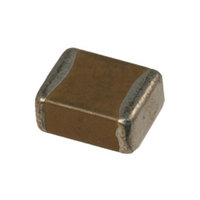12101C224KAT2A AVX Corporation, 12101C224KAT2A Datasheet - Page 13

12101C224KAT2A
Manufacturer Part Number
12101C224KAT2A
Description
CAP CERM .22UF 10% 100V X7R 1210
Manufacturer
AVX Corporation
Series
1210r
Specifications of 12101C224KAT2A
Capacitance
0.22µF
Tolerance
±10%
Package / Case
1210 (3225 Metric)
Voltage - Rated
100V
Temperature Coefficient
X7R
Mounting Type
Surface Mount, MLCC
Operating Temperature
-55°C ~ 125°C
Applications
General Purpose
Size / Dimension
0.126" L x 0.098" W (3.20mm x 2.50mm)
Thickness
1.52mm Max
Voltage Rating
100 Volts
Operating Temperature Range
- 55 C to + 125 C
Temperature Coefficient / Code
X7R
Product
General Type MLCCs
Dimensions
2.5 mm W x 3.2 mm L x 2.100 mm H
Termination Style
SMD/SMT
Dielectric Characteristic
X7R
Capacitance Tolerance
± 10%
Capacitor Case Style
1210
No. Of Pins
2
Capacitor Mounting
SMD
Rohs Compliant
Yes
Case Size
1210
Material, Element
Ceramic
Termination
SMT
Voltage, Rating
100 VDC
Lead Free Status / RoHS Status
Lead free / RoHS Compliant
Features
-
Ratings
-
Lead Spacing
-
Lead Free Status / Rohs Status
Lead free / RoHS Compliant
Other names
478-1616-6
Available stocks
Company
Part Number
Manufacturer
Quantity
Price
Part Number:
12101C224KAT2A
Manufacturer:
AVX
Quantity:
20 000
General Description
Effects of Mechanical Stress – High “K” dielectric
ceramic capacitors exhibit some low level piezoelectric
reactions under mechanical stress. As a general statement,
the piezoelectric output is higher, the higher the dielectric
constant of the ceramic. It is desirable to investigate this
effect before using high “K” dielectrics as coupling capaci-
tors in extremely low level applications.
Reliability – Historically ceramic capacitors have been one
of the most reliable types of capacitors in use today.
The approximate formula for the reliability of a ceramic
capacitor is:
where
Historically for ceramic capacitors exponent X has been
considered as 3. The exponent Y for temperature effects
typically tends to run about 8.
A capacitor is a component which is capable of storing
electrical energy. It consists of two conductive plates (elec-
trodes) separated by insulating material which is called the
dielectric. A typical formula for determining capacitance is:
Capacitance – The standard unit of capacitance is the
farad. A capacitor has a capacitance of 1 farad when 1
coulomb charges it to 1 volt. One farad is a very large unit
and most capacitors have values in the micro (10
(10
Dielectric Constant – In the formula for capacitance given
above the dielectric constant of a vacuum is arbitrarily cho-
sen as the number 1. Dielectric constants of other materials
are then compared to the dielectric constant of a vacuum.
Dielectric Thickness – Capacitance is indirectly propor-
tional to the separation between electrodes. Lower voltage
requirements mean thinner dielectrics and greater capaci-
tance per volume.
Area – Capacitance is directly proportional to the area of
the electrodes. Since the other variables in the equation are
usually set by the performance desired, area is the easiest
parameter to modify to obtain a specific capacitance within
a material group.
68
V
.224 = conversion constant
L
L
V
-9
o
o
t
t
) or pico (10
C = capacitance (picofarads)
K = dielectric constant (Vacuum = 1)
A = area in square inches
= operating life
= test life
= test voltage
= operating voltage
t = separation between the plates in inches
(thickness of dielectric)
(.0884 for metric system in cm)
-12
L
L
) farad level.
o
t
=
C =
V
V
o
t
X
.224 KA
X,Y = see text
T
T
T
T
o
o
t
t
t
= test temperature and
= operating temperature
Y
in °C
-6
), nano
Energy Stored – The energy which can be stored in a
capacitor is given by the formula:
Potential Change – A capacitor is a reactive component
which reacts against a change in potential across it. This is
shown by the equation for the linear charge of a capacitor:
where
Thus an infinite current would be required to instantly
change the potential across a capacitor. The amount of
current a capacitor can “sink” is determined by the above
equation.
Equivalent Circuit – A capacitor, as a practical device,
exhibits not only capacitance but also resistance and
inductance. A simplified schematic for the equivalent circuit
is:
Reactance – Since the insulation resistance (R
ly very high, the total impedance of a capacitor is:
where
The variation of a capacitor’s impedance with frequency
determines its effectiveness in many applications.
Phase Angle – Power Factor and Dissipation Factor are
often confused since they are both measures of the loss in
a capacitor under AC application and are often almost
identical in value. In a “perfect” capacitor the current in the
capacitor will lead the voltage by 90°.
R
C = Capacitance
s
dV/dt = Slope of voltage transition across capacitor
= Series Resistance
X
R
X
Z = Total Impedance
C
L
s
Z =
L
C = Capacitance
E = energy in joules (watts-sec)
V = applied voltage
C = capacitance in farads
I = Current
= Series Resistance
= Capacitive Reactance =
= Inductive Reactance
R
2
S
+ (X
I
C
ideal
- X
R
= C dV
E =
S
L
)
2
1
dt
⁄
2
CV
R
L = Inductance
p
2
= Parallel Resistance
= 2 π fL
2 π fC
1
R
C
P
p
) is normal-










